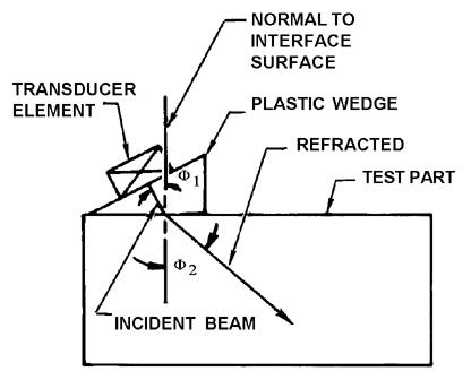T.O. 33B-1-1
5-8
5.1.4.4
Lamb Waves.
Lamb waves, also known as plate waves, propagate within thin plates, a few wavelengths thick. Lamb waves may be
generated in an infinite variety of modes whose velocity is dependent on the incident angle, the frequency, the plate
thickness, and the properties of test material. Calculation of Lamb wave modes is complex, and is generally not
required. However, when Lamb waves are generated in material thinner than one wavelength, the velocity can be
determined by noting the relative positions of the echoes as a function of distance.
5.1.5
Refraction and Mode Conversion.
5.1.5.1
Snell’s Law.
When a sound beam passes from one medium into another with a different sound velocity, at an angle not normal to the
interface separating the two media, refraction (a change in propagation direction) occurs (see Figure 5-10). The
incident and refracted angles follow Snell's law:
sin
sin
f
f
1
2
1
2
=v
v
Where:
f1 (phi) = angle between the normal to the interface surface and the incident sound beam
f2 = angle between the normal to the interface surface and the refracted sound beam
v1 = velocity of incident sound beam
v2 = velocity of refracted sound beam
Figure 5-10. Sound Beam Refraction.
5.1.5.2
Multiple Refracted Beams.
When an incident longitudinal beam is normal to the test part surface (f1 = 0°), the longitudinal sound beam is
transmitted straight into the test part and no refraction occurs. When the incident angle is other than normal,
refraction and mode conversion occur. A portion of the longitudinal incident beam is refracted into one or more wave
modes traveling at various angles and intensities depending on the incident angle of the longitudinal beam. The angles

